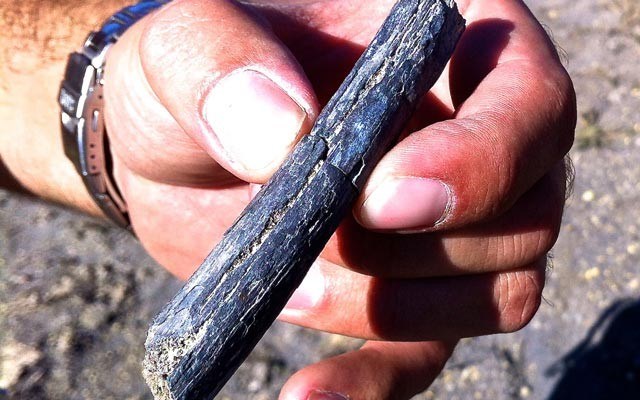If you haven't heard of the Canadian Fossil Discovery Centre in Morden, Manitoba, don't worry, I hadn't either until I arrived there on a recent assignment for Canadian Geographic. But my first thought upon my own discovery was this: why hadn't I heard of it?
Despite the ignominy of being lodged in the basement of a community facility that also features hockey rinks, a play centre, Manitoba's Baseball Hall of Fame and several displays on early farming, the CFDC houses an assortment of mid-Cretaceous squid, birds, sharks, fish and the largest collection of marine reptile fossils in Canada, including giant turtles, long-necked plesiosaurs and numerous mosasaurs — the fiercest sea creatures known and the reason Cretaceous oceans are deemed to have been the most dangerous place to swim, ever.
Descending the ramp into the museum you shadow a wall that cleverly replicates the sediments that are key to the fossil story. To begin, during the mid- to late-Cretaceous period, from about 90 to 65 million YBP, this area lay under the waters of the vast but shallow Western Interior Seaway, connecting the Arctic Ocean to the Gulf of Mexico and teeming with marine life. Manitoba was at the seaway's eastern edge, and it was into the sediments of this near-shore basin that myriad expired life descended. Second, the Pembina Escarpment, rising 100-130 metres above the prairie in south-central Manitoba marks the boundary of the post-glacial super-lake known as Agassiz, and was formed originally by the undercutting of those Cretaceous sediments by the ancestral Red River, then later steepened by glacial and water scouring to expose its ancient fossils.
Discovery of these, however, begins with the ejecta of long-extinct Rocky Mountain volcanoes in Wyoming and Montana, whose periodic ash plumes settled over this area of the seaway; the ash reacted with sea water and mud to became bentonite, a mineralized clay used in sealants, lubricants, and as an additive to everything from steel to toothpaste. The sunken ash was covered with other sediments between eruptions, creating a layer-cake of dark, loose, fossiliferous shale and lighter, commercially valuable bentonite, the latter mined in a way that carefully stripped away the bentonite to reveal fossils in the shale layer below. Although the first mosasaur finds were made in 1934 when the first bentonite claims were staked, no local parties were particularly interested, educated or given to acceptance of the amount of Earth's history represented here (the region is a deeply religious enclave of mostly Mennonite settlers).
Tens of thousands of fossils were destroyed before volunteer caretakers found out about the finds being made at the escarpment's various bentonite mines. Volunteers like Don Bell and Henry Isaak, English and science schoolteachers respectively who'd drive out at night after the mining ops had shut down to remove the fossils. They'd circle a convoy of vehicles around the exposed bones, turn their lights on for illumination, and rapidly and crudely plaster-jacket everything. With so much material emerging from the quarries, they soon filled their garages with jacketed specimens. When their spouses finally forced them to find alternative storage they established a local museum that would eventually become the CFDC. The schoolteachers' enthusiasm, reverence and treatment of fossils quickly inspired many bentonite miners to shut down every time they came across something and wait for the teachers to remove it.
Plenty of amazing material surfaced at bentonite mines or nearby farms, including the CFDC's star mosasaur, Bruce, whose 13-metre skeletal replica fills an entire room to end a tour of the facility. The nasty set of teeth and size of the skull — with movable jaws that could open to engulf massive prey — explains why mosasaurs are often referenced as the "T. Rex of the seas." Furthering its notoriety, Bruce (actually a female) was recently certified as the world's largest mosasaur by none other than the Guinness Book of World Records.
To get a feel for the work I joined a mosasaur dig at "The Ditch," one of the CFDC's 30-some sites. Formed when a culvert was run under a roadway to drain an overflowing farm pond, subsequent erosion opened up a 15-metre wash that cuts down through wavy bentonite and shale deposits and literally regurgitates fossils. Here, in 2011 CFDC techs found a scene worthy of a Japanese horror movie—a Clidastes mosasaur skeleton locked in some kind of death battle with a five-metre predatory fish known as Xiphactinus. While digging down to where they thought some of that 83 million-year-old omellete extended into the bank, they'd encountered a glitch — another mosasaur above it in a different layer. It was this creature that was now exposed on the quarry floor and being carefully cleaned centimetre by centimetre with soft-bristled brushes. Close against the excavation wall were a couple of smallish mosasaur vertebrae and phalanges (fin bones), a large shoulder blade, and several ribs arched over a mess of stomach contents — small-to-tiny bones that included fish and bird bits. The fossil spine scatters to the far wall where it's capped by more ribs and some huge vertebrae recently excavated by a father and daughter from North Dakota. Stories like this abound; a couple years back, at another site, Scottish tourists had the treat of finding a 10-metre mosasaur and naming it Angus. The ability for members of the public to learn by the experience of participating in digs is a big part of the CFDC's appeal. After all, you can't go to a zoo and start taking care of the lions without risking your life, but any five-year-old with good eyes and curiosity can make an important paleontological discovery.
And you can't forget the personal appeal, the gratification of watching recognizable shapes of organic life emerging from what seems an otherwise random matrix of dirt, minerals and rock bits. What did I learn in the end? That there's an ocean underfoot in southern Manitoba, and it's filled with marvelous creatures.




